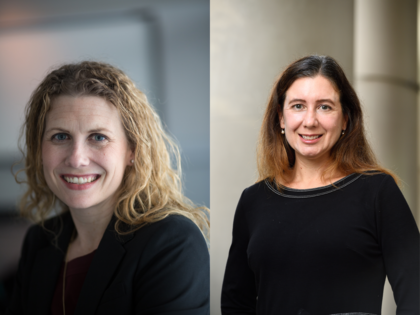In 2022, Johns Hopkins Bloomberg School of Public Health faculty members Heather Volk and Christine Ladd-Acosta won a $11.7 million, five-year Autism Center of Excellence grant from the National Institutes of Health to conduct a sweeping study on autism.
NIH funds for the Autism Center of Excellence come from the Autism CARES Act, legislation dating back to George W. Bush's presidency. Over more than two decades, the CARES Act has significantly advanced autism research by dedicating $5.2 billion in funding to the NIH, Centers for Disease Control and Prevention, and Health Resources and Services Administration.

Image caption: From left: Heather Volk, Christine Ladd-Acosta
Though the budgets of these agencies have come under scrutiny recently, and the NIH has proposed significant cuts to its research funding, projects like the one Volk and Ladd-Acosta are leading are vital to the United States maintaining its standing at the forefront of medical innovation. Research funded by Autism CARES has already made a difference in the lives of countless people across the country. Thanks to breakthroughs in our understanding of autism—its prevalence, co-occurring mental and physical health issues, and disparities experienced by those living with it—early intervention services have improved, children on average are being diagnosed earlier, and more personalized approaches to medical care and daily supports are possible.
With their research, Ladd-Acosta and Volk hope to take these advancements even further.
Their project, called GEARs (Combining Advances in Genomics and Environmental Science to Accelerate Actionable Research and Practice in ASD), is housed within the Wendy Klag Center for Autism and Developmental Disabilities at the Bloomberg School. It aims to pinpoint the environmental factors that increase a child's likelihood for developing autism. While genetics plays a clear role in autism, DNA alone doesn't fully account for the large number of children identified with autism in the U.S. Volk and Ladd-Acosta, along with the large research team they have assembled, are studying how the interplay of genetics and environmental factors might increase the likelihood of autism symptoms and co-occurring health conditions. Their ultimate goal is to identify ways to improve the lives of people living with autism, especially those who experience co-occurring problems like seizures, depression, or gastrointestinal issues.
The Klag Center is uniquely positioned to carry out this project due to its vast global network—with 18 research centers from around the world participating in the study, the GEARs team has a wealth of data from more than 175,000 participants to analyze. That data includes everything from surveys about environmental exposures to medical chart data to biologic samples.
Due to the complex set of genetic and environmental factors at play in the development of autism, epidemiological studies alone won't tell the whole story. That's where Thomas Hartung and Lena Smirnova come in. The two Bloomberg School professors are growing brain organoids, three-dimensional clusters of neurons that self-organize into a kind of mini-brain, using samples of skin cells taken from individuals diagnosed with autism. These organoids will allow Hartung and Smirnova to see the impacts of different environmental factors on neurodevelopment in the context of different genes, meaning results that emerge from the human observational data sets can be tested in the lab.
Getting a project of this size off the ground requires a significant amount of work; the first year alone was consumed by navigating paperwork and data permissions. But now, GEARs is positioned to dive into the actual research. Thanks to NIH funding, a research team has been hired, onboarded, and is already at work on data collection, analysis, and organoid growth. This is the largest study of gene-environment interactions for autism in the world—a study that would not be possible without federal support.
"As a public health researcher, so much of my work draws on resources from the U.S. government," Volk says. "With funding from NIH, I've received training that's been integral to my career. I would not be here without it. It's my goal to use that investment to not only work to understand autism and neurodevelopmental disorders and improve health of persons and families impacted, but to help other scientists in public health want to do so. Our network can help address critical research gaps about the environment, and how it works with genetics, while providing a platform for future research and scientists to develop their own careers, too."
Learn more about this research in the Hopkins Bloomberg Public Health Magazine






